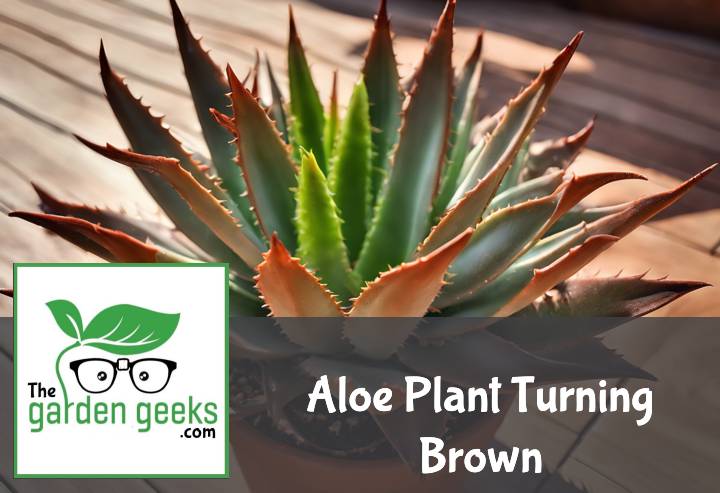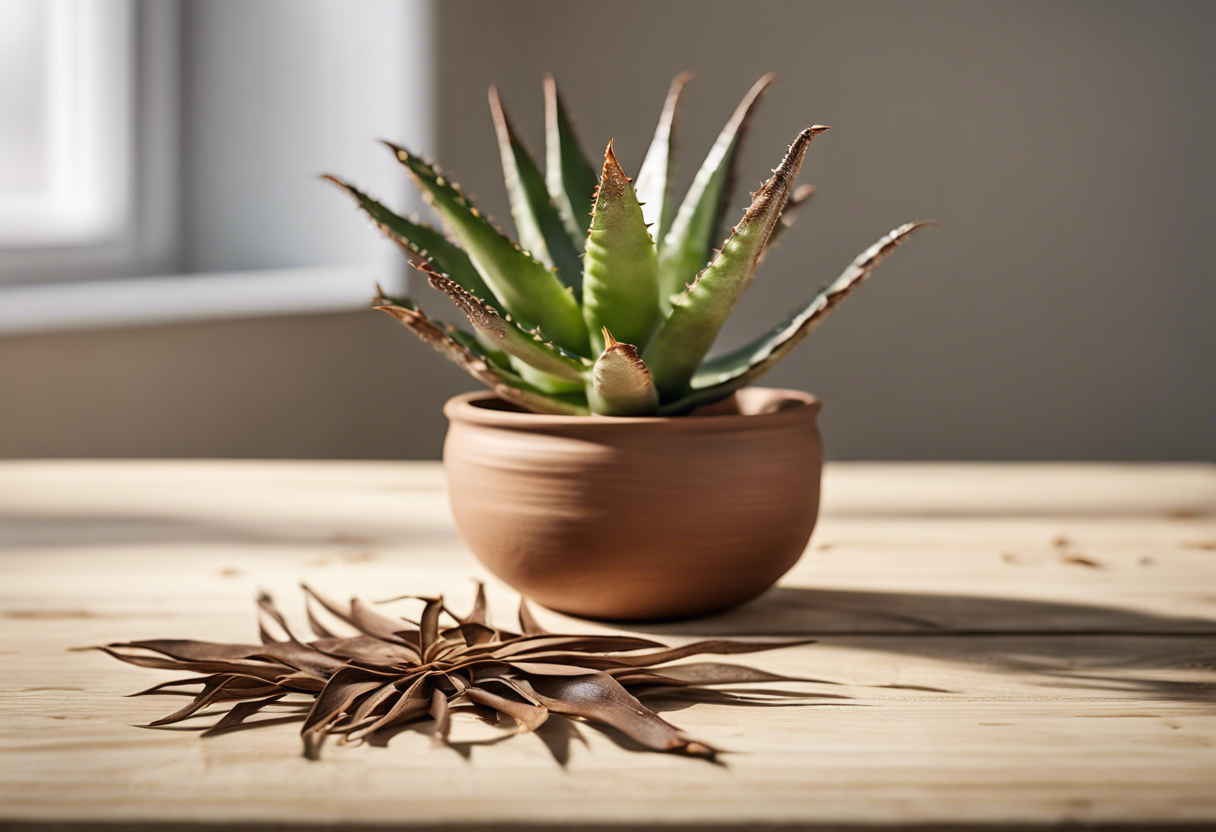Ever glanced at your once vibrant and green aloe plant, only to find it looking a little…well, let’s just say not-so-green? Suddenly, you’re in the midst of a botanical whodunit, with your Aloe Plant Turning Brown playing the victim. It’s enough to make any plant parent break out in cold sweat!
But fear not! This isn’t an episode of ‘CSI: Plant Edition’. More often than not, it’s just your aloe sending you some SOS signals. So buckle up as we dive into this leafy mystery and figure out how to bring your aloe back from the brink. Keep reading about Aloe Plant Turning Brown? (How to Save it)
Key Takeaways
- Aloe plants turn brown due to overwatering, poor lighting, or disease.
- Overwatering causes root rot which leads to browning. Water only when the soil is dry.
- Insufficient light can cause browning. Place your aloe in bright, indirect sunlight.
- Diseases like fungal infections can also cause browning. If infected, remove the diseased parts and apply a fungicide.
- To save a brown aloe plant, adjust watering habits, improve lighting conditions, and treat any diseases promptly.
Why is My Aloe Plant Turning Brown?
Ever wondered why your aloe plant is taking on a brown hue? Well, it could be due to natural color variations or common causes of browning. Let’s dive into the world of aloe plant care and figure out what’s going on with those brown aloe leaves.
Understanding the Natural Color of Aloe Plants
First things first, don’t panic! Some color variation in aloe plants is absolutely normal. It doesn’t necessarily mean your indoor aloe plant turning brown is facing an apocalypse.
The natural color of aloe plants can range from bright green to a deep, earthy shade. So, if you’re seeing some green shades in aloes that are leaning towards brown, it might just be part of their charm!
Remember, understanding the difference between healthy vs unhealthy aloe colors is key to successful aloe vera plant problems solving.
Common Causes of Browning in Aloe Plants
Now let’s talk about some not-so-natural reasons for your aloe plant turning brown. Overwatering is one common culprit. Yes, even plants can have too much of a good thing!
If you’re giving your aloes more water than they need, it might lead to soggy roots and ultimately cause those dreaded brown aloe leaves. On the other hand, insufficient light can also cause browning in aloes.
So keep an eye on these two factors when dealing with common problems with aloes. With proper care and attention, you’ll be well on your way to fixing those brown leaves and saving your beloved aloe plant!
Diagnosing the Problem: Why is My Aloe Plant Turning Brown?
When your aloe starts sporting a brownish hue, it’s time to play detective. Aloe plant diagnosis isn’t rocket science, but it does require some attention to detail. You’ll need to examine both the plant and its environment.
Examining the Plant’s Appearance
First things first, take a good look at your aloe. Is it just browning or are there other signs of distress? Spotting unhealthy plants can be as simple as noticing changes in appearance.
Maybe you see some brown spots on aloes, or perhaps the leaves are wilting. These could be clues that your plant is crying out for help. Remember, an aloe plant appearance can tell you a lot about its health.
Assessing the Growing Conditions
Next up, let’s consider where your aloe is living. A common cause of an aloe plant turning brown can be less-than-ideal growing conditions.
Is your plant getting enough light? Aloes love sunlight but not too much! So check those light requirements for aloes and adjust accordingly.
And what about water? Overwatering is often the culprit when it comes to browning aloes. Make sure you’re watering aloes properly, folks!
Finally, think about temperature and humidity levels – these also play a part in creating an ideal environment for aloes. So don’t neglect these factors during your investigation!
How to Save a Brown Aloe Plant?
Is your Aloe Plant Turning Brown? Don’t panic! It’s usually due to some common issues that can be fixed with a little TLC. Let’s dive into the solutions.
Adjusting Watering Practices
Firstly, let’s talk about watering. Overwatering is often the culprit behind a brown aloe plant. Too much H2O can lead to root rot, causing your plant to turn brown. On the flip side, underwatering isn’t great either. Aloes are desert plants and while they do like their dry spells, they also need water to thrive.
So what’s the solution? Well, it’s all about balance. A good rule of thumb is to let the soil dry out completely before watering again. This prevents overwatering and keeps your aloe happy.
Modifying Light Exposure
Next up: light exposure. Yes, aloes love their sunbaths but too much of anything isn’t good. Excessive sunlight can cause sunburn in aloes, leading to browning leaves.
But don’t worry! You don’t have to keep your plant in total darkness either. Just ensure it gets indirect sunlight or place it in an area with filtered light for most of the day.
Changing Soil and Potting Conditions
Lastly, let’s talk dirt – literally! Poor soil quality or improper potting conditions can make your Aloe Plant Turning Brown faster than you can say “aloe vera”.
The best soil for aloes is well-draining and slightly acidic. As for potting, ensure your pot has enough drainage holes at the bottom so excess water doesn’t sit around causing root rot.
Remember folks, saving a brown aloe plant isn’t rocket science! With these tips on hand, you’ll have your green thumb working its magic in no time!
Prevention Tips for Future Browning
Alright, let’s talk about how to keep your aloe plant from turning into a brown mess in the future. It’s all about aloe plant care and knowing the difference between healthy and unhealthy signs.
Ideal Care for Aloe Plants
First off, let’s chat about the best practices for caring for an aloe plant. You’ve got to be like a helicopter parent with these guys. They need just the right amount of light – not too much, not too little.
Next up is water. These plants are desert dwellers, so they don’t need a ton of H2O. Overwatering can lead to root rot which can cause your aloe plant turning brown.
Finally, temperature is key. Aloes love warm weather but can’t handle freezing temps. So if it gets chilly, bring ’em inside! That’s how you prevent browning and maintain a healthy aloe.
Signs of Healthy vs Unhealthy Aloe Plants
Now onto spotting the good from the bad in terms of aloe plant health. A healthy aloe is usually bright green with firm leaves that stand upright.
On the flip side, an unhealthy one might have leaves that are soft or wilting. And if they’re turning brown or yellow? That’s a big red flag!
Remember folks, understanding these physical indicators of aloe health can save your plant from going down the drain! Keep an eye out and happy gardening!
To Wrap Up
Just like a teenager after a break-up, your Aloe Plant Turning Brown might just need some TLC and alone time. Remember, too much water is like an overbearing ex – it’s suffocating!
So, let’s not drown our green buddies in love (or water), okay? Keep it cool, keep it casual, and your aloe will be back to its vibrant self in no time!





